How to Make a Sword Scabbard by Ye Olde Gaffer
Oct 19, 2013 9:35:28 GMT
Post by Jack Loomes on Oct 19, 2013 9:35:28 GMT
How to Make Scabbards - By Ye Olde Gaffer
I recently tried my hand at some scabbards for a couple of my swords. They are not an easy project, but not as bad as I thought they would be. It is best if you have some leather working experience before you try one, but you don't have to be a leather expert. This project shows the construction of earlier types of scabbards but the idea is pretty much the same for any time line... wood core, covered with leather, some type of belt system....
Please keep in mind that I am not in any ways or means an "expert" in the art of making scabbards. There may be other ways to do this, it is just the way I do it, and I am open to to any comments or suggestions.
Carving Method
This method is how the more expensive scabbards are made, and is a more historic method of producing the wood core.

The first thing you will want to do is to create the wood core. The wood of choice appears to be poplar and that is what I used for my second core. The first core I used was oak, and I have heard that oak might not be the best choice (the oils in oak might not be good for steel?). So I will suggest poplar!
You will want to get two pieces of poplar that are 1/4" thick and a bit longer and wider then your sword blade. You will want to lay your sword, centered, on the each board and draw a pencil line all away around the blade. (see picture above)

Next you will want to chisel, sand, grind, half of the width of the blade from both pieces of the core wood. To be honest this is a bit of a pain, but be careful here, go slow, it is hard to add wood back. When you think you are getting close, clamp both pieces of the core together temporarily, and test fit the blade. Again, just a lot of hit and miss here... but did I mention... go slow!. Keep in mind the shape of the fuller, the distal taper, etc. as you are carving this. The blade should fit snugly, somewhere between falling out, and not having to hammer it in. If you do get it too lose not all is lost. You can add some very thin leather near the mouth to hold the sword in. But not TOO loose... if it is like throwing a hotdog down a hallway then it is way too loose... start over. (the wood is very inexpensive). (see picture above)
Note: I would like to add that it was mentioned that using sandpaper on the inside of the core might result in a bit of the "sand" to be embedded into the core. This could cause a scratching on the blade and to remove the grain of sand you would probably need to destroy the scabbard to get to it. So either do not use sandpaper on the interior of the core, or if you do make sure the core is cleaned good so that no grains will remain.
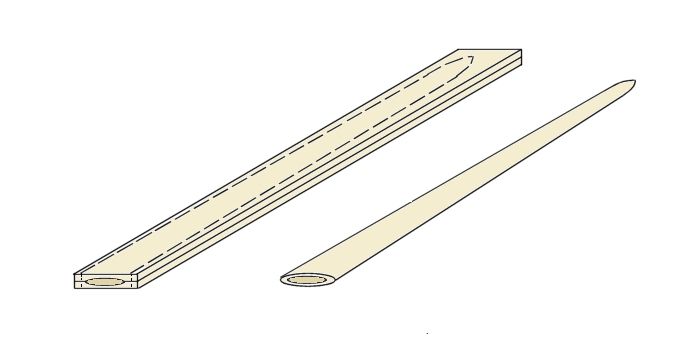
When are satisfied with the fit then you are ready to glue the two halves together. If you wish you can cut the outside shape before you glue them together, or you can cut them as one piece after you glue them together. Whichever way you choose, be sure that you leave enough room around the core so you don't cut into the grove you have chisled out. You may wish to center the blade on the outside of the core and draw around it as a guide.
If you are using a chape don't forget that you will need to take this into account when shaping the core. I sanded mine until the chape was just a little loose, so it would fit over the leather. Chapes are not easy to find. I actually used the one that came with my swords fiberglass scabbard.
A Historic Method
The "Slat" method project shown below - a simple way to create a core.
Thin slats of wood that are formed over the blade (either formed by steaming/soaking or by cutting), or layers of veneer glued in layers on each side can be seen on surviving examples.
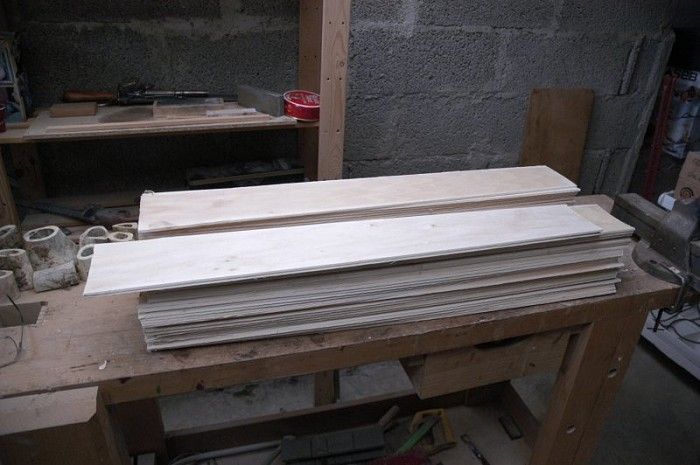
The above picture shows a pile of poplar slats. When Jean recieved these they were veneer cuts, (not cut like regular lumber that most of us would purchase), and still damp (I would assume green), which means they have a bit of natural curve, and ready to be wrapped around the blade.
If you purchase a normal piece of poplar wood slate you will need to steam them(best), or soak them so that they can be bent in a curve. They will also need to be thinned down, with either a planner or sander before steamin/soaking. These slats appear to be around 3/16" thick.

Next you will want to oil the blade well, and then glue and clamp the two halves together. Notice that shape of the scabbard has already been cut out.
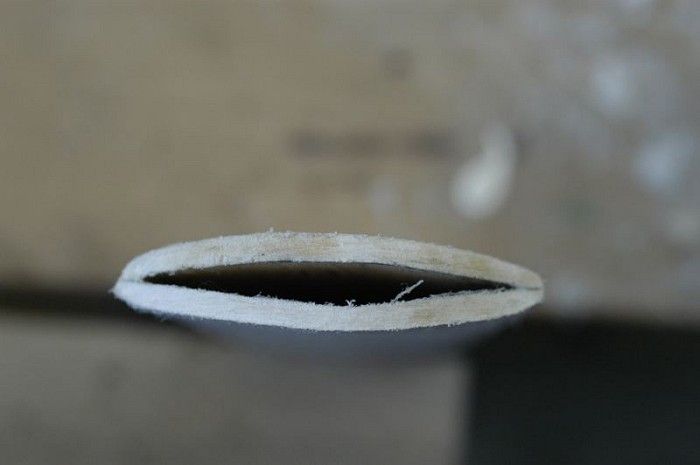
Here is a shot looking into the mouth of the scabbard.
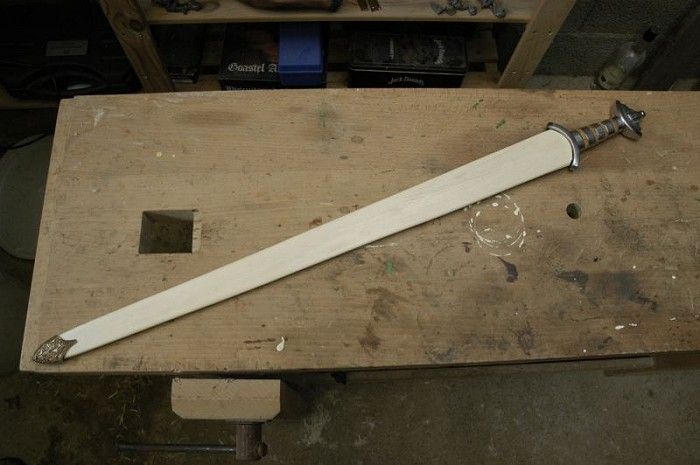
The above photo shows the finished core. Looks very nice and clean.
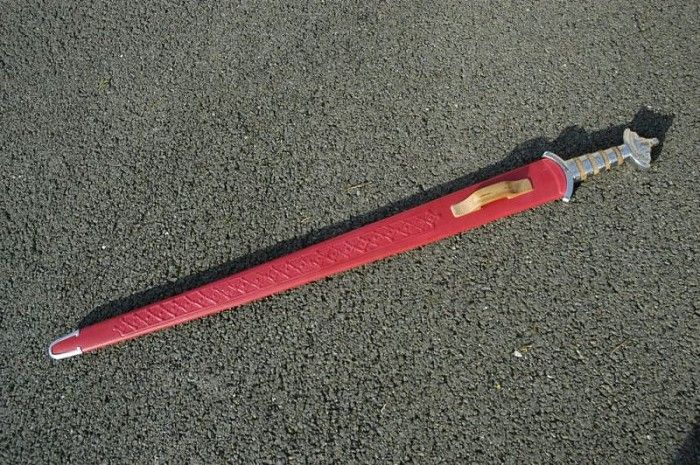
Easy Method
Ok, so this is not really easy, but trust me, it is easier then the above the carving method. This method basiclly makes a 1/4" slot for the blade to slide into. If you happen to have a blade that is thicker than 1/4" then the two side pieces will need to be thicker. If the blade is a bit thinner then a 1/4" (more common), then you can add a bit of leather in the opening to make a very nice, snug fit. This is the method that I used on both of my scabbards below.
For this method you will need two pieces of the 1/4" thick boards a bit longer and wider then your blade. You will also need two side pieces. 1/4" x 1/2", and a bit longer than the the blade should do it.
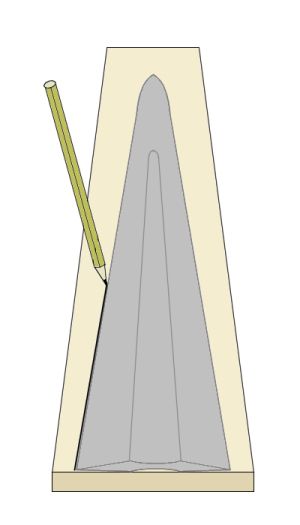
The first thing you will need to do is lay down your blade on the wood and trace around it with a pencil. You will need to do this on two pieces of wood.
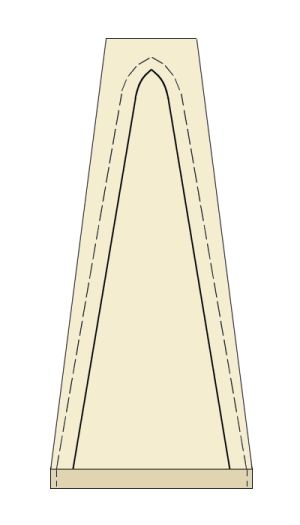
The drawing above shows the pencil tracing of the blade (dark line), and the dotted line shows where you will need to cut it. I usally allow about 3/8". This gives enough room for shaping and sanding. Again, this will need to be done on two pieces of wood.

This picture shows the two pieces of wood glued on. You might notice that I have also shown a small piece of wood glued on near the tip of the scabbard.
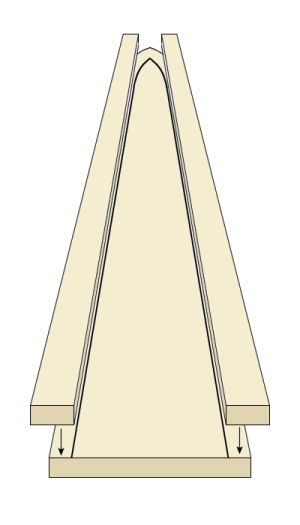
Now we will glue on the "top" piece of the scabbard. Try and align it up so it matches the "bottom" piece.

The above drawing shows the scabbard with all of the pieces glued together. Let this dry for a couple of hours.
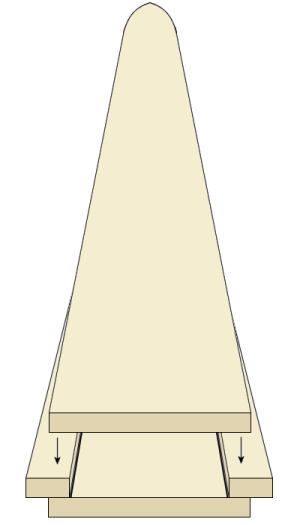
The last step will be to cut or sand the two pieces that separate the top and bottom parts flush with top and bottom piece.

The last step will be to take the "square" wood scabbard we have made and make it into a nice oval shape. Go slow here, you don't want to remove too much wood!

The above is an actual photo of one of the scabbards I show below. My blade was just a bit loose so I glued a small piece of leather inside the opening, and now the blades fits snug.
After the glue dries you are now ready to shape the core to it's final shape. I use a belt sander for the rough shape, and then finish up with a hand sander. Again, go slow here. You do want to end up with a thin core, but you don't want to sand into the grove. My first core was thicker then my second one, as I had a little more idea what I was doing.
The last step on the core is to finish the outside with a vanish. This protects the core in the long run, and keeps the core from sucking all the moisture from the leather as you are working with it.
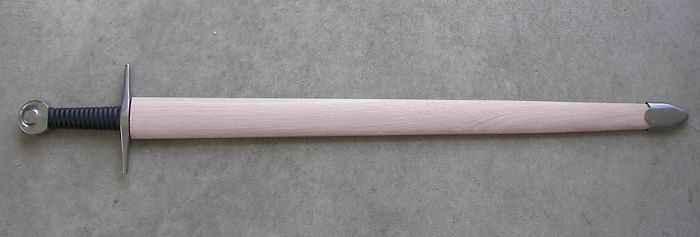
My completed core.
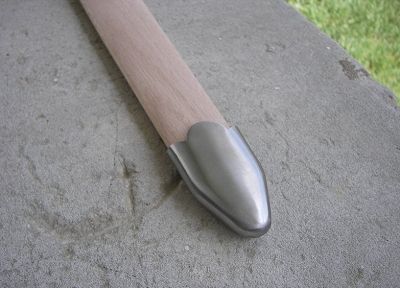
The chape end of the core. Notice the chape is a bit loose here... so it will fit over the leather.
Another shot of the core with the blade inserted.
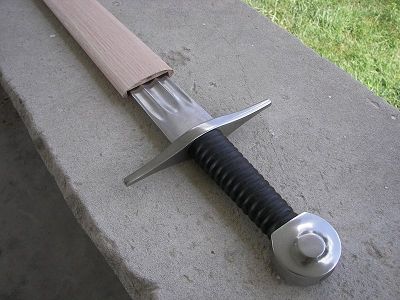
Working with the Leather
I will show several shots of my project in progress.
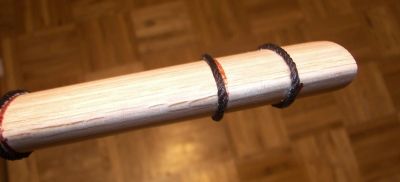
This picture shows the top pair of risers. I used some small nylon twine that I super glued on.

Here you see both sets of risers and the piece of leather that I used. You will want to use 2 to 3 oz vegetable tanned leather. You can also see all of the holes that you get to punch into the leather. Try to keep the holes evenly spaced from the edge and each other.
Remember to leave some extra leather at the top of the scabbard for the hilt cover.
Figuring out what size to cut the leather is a bit of trial and error. Again, go slow, and trim the width a little at a time. There is no trick here that I am aware of and I have even heard the experts struggle with this a bit. You will be wetting the leather (I soak mine for about 30 minutes) and this will let it stretch a bit. Keep in mind though that when the leather dries it will tighten up.
This would be much easier to size if the scabbard was the same size all the way through it's length, but most will angle smaller towards the chape. If this is your first time trying this you may wish to practice with some paper first.

You don't want too much gap when fitting the leather around the core.

Don't size the leather so that it has wrinkles. You want the finished leather to look taut.

Just a small gap will ensure a nice taut leather cover over the core. When you wet the leather it will be easy to pull this small gap close, and then when it dries it will stretch nicely around the core.
Handle the wet leather carefully. Wet leather is almost clay-like, and it will easily show your fingernails, and dents if you bang it on something while working on it. Of course this may be the look you are after!
Watch the needles while sewing... I will be damned if I can't keep from sticking myself a couple of times every time I sew leather... ouch! I pretty much use artificial sinew thread, but you can also use heavy duty waxed leather thread. DO NOT use regular sewing thread... it is not strong enough.

Here is the leather at the chape end ready to be sewed.
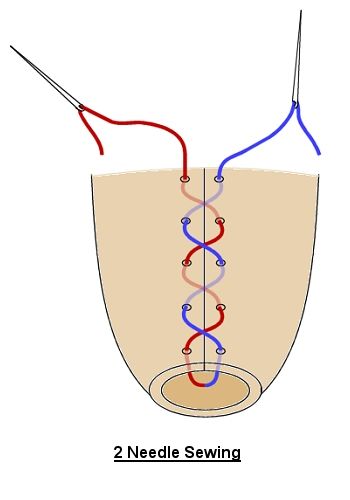

The above drawings show how I use the 2 needle method to sew. This is one of many that can be used, but it is my preference. Keep in mind you don't use blue or red thread, I am just showing the thread in these colors to make it easier to follow. This type of sewing is much like lacing a pair of boots. Trying to figure out how much thread to use is a bit of a guess but around 4 times the length of the scabbard is a good start. It is a little tough when you first start as there is a lot of thread to pull through, but as you move up it gets shorter.
Try to keep the split in the leather running straight up the scabbard as you are sewing. If you do run out of thread while sewing you can tie off a knot (A) and then continue (B) just like you started. Make sure you tie the knot UNDER the scabbard leather so it doesn't show.
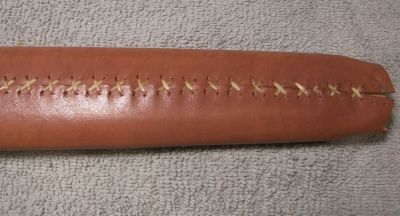
This shows the back of scabbard (wet leather) with the sewing completed.
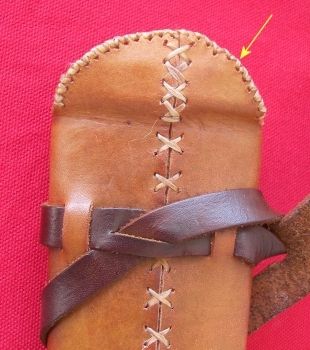
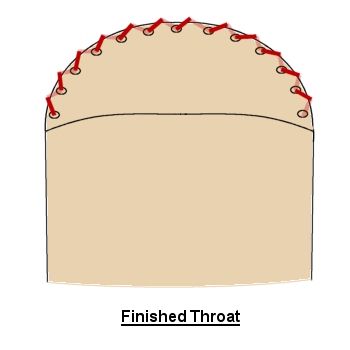
The above pictures shows how I finished the throat of the scabbard. This gives it nice finished look. I sewed all around the throat in one direction, then reversed and sewed back the other way. I only use one needle for this operation.
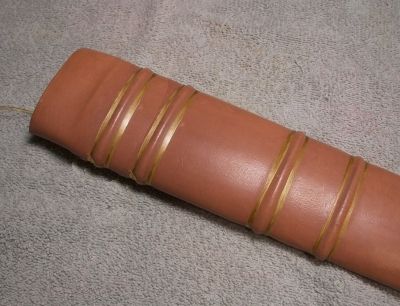
The above picture shows artificial sinew wrapped around the risers to give them detail. After the leather dries you will remove them.
Keep in mind that the risers were used on this scabbard because of the paticular type of suspension I was using. You may wish to change the spacing of them or not even apply any.
The three pictures below show different examples of hanging scabbards on a belt.

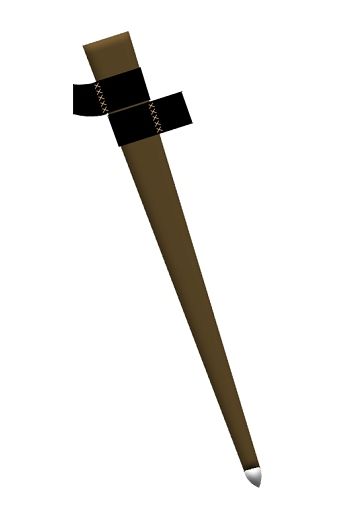
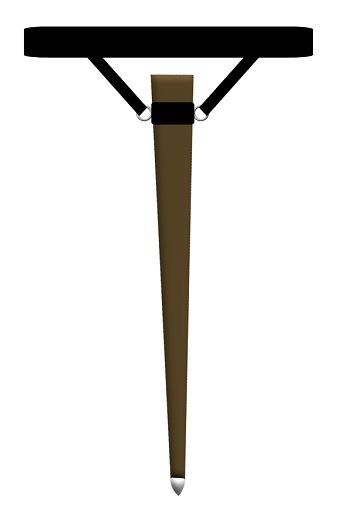
Finishing The Scabbards
I use standard Tandy leather dye to most of my leather. The finished scabbard on the left (below), was finished by staining, and then using a wet sponge I rubbed it down giving it a bit of an antique look. The scabbard on the right was finished by spraying the stain on with a cheapie spray outfit. Spraying will let the stain be more even, and lighter in color. Both belts on the below scabbards were stained by brushing on the stain using a wool dauber. ALWAYS test colors on some scrap leather. What they show and what you get can be two very different things. Even the same color on two different types of leather can show major color differences.
I finish them off by applying 3 coats of paste wax.
Two of My Completed Laced Belt Scabbards
Both of these are a bit simple, as I didn't add any carving or stamping on these scabbards. I do plan on making my next one a bit fancier. I will post some pictures of it when I have completed it.
I am actually suprised how comfortable these are to wear.
Hopefully the pictures below, will show some of the details.
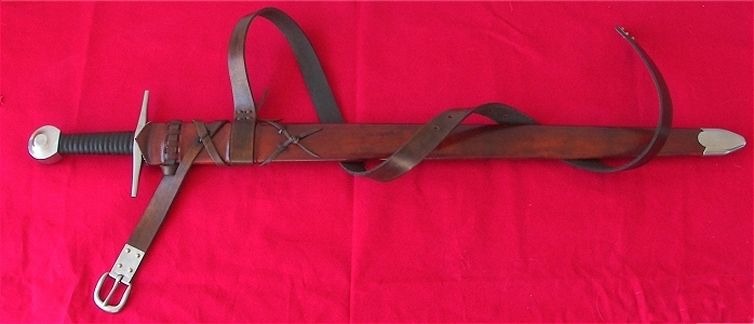
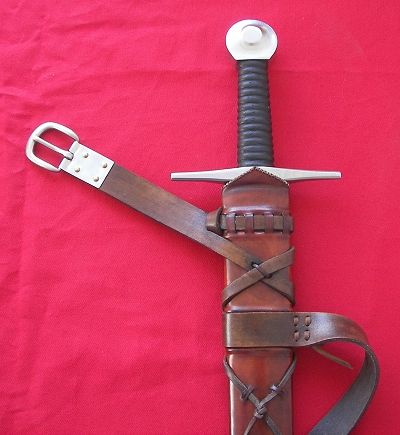
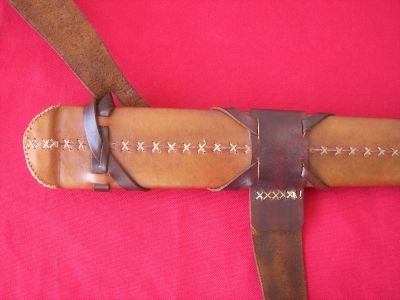
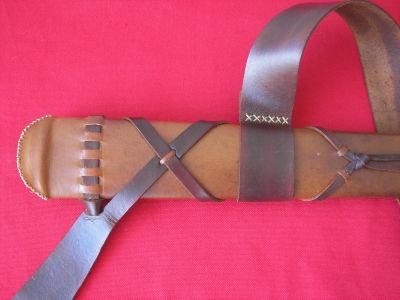

Lacing the Scabbard
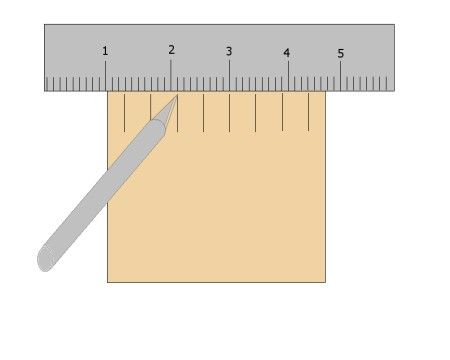
I always build the entire scabbard first before I do any staining. All the instructions below assume the scabbard is still a bit wet so the leather will stretch nicely around all of the straps. The first thing you want to do is to create the slits on the top of the scabbard. You need to determine the spacing and size of the slits to be cut. This is a matter of personal taste, on this project I am using five. I try to evenly space them so that the slits and the spaces between them are equal, again, a matter of personal taste.
Carefully measure them and mark the leather lightly with a pencil or an awl. Next using an X-Acto knife cut the slits on the lines as shown in the graphic above. You will want to cut the slits just a bit longer then the width of the strap that will be going through them. In other words, if you are using a 1/2" strap, then cut the slots about 5/8" long. Be careful here... don't let the knife slip. Also don't cut much deeper then the leather thickness, a little cut into the wood is ok.
NOTE: Act like the scabbard in all the below pictures has not been stained yet. It was easier to take pictures after I completed everything, and then take it back apart.


Next while the leather is still a bit wet you will feed the leather strap through the slits as shown above. This might be a bit tough to feed through, and you can use a small screwdriver to pry up the slits a bit as you are feeding the leather through. Wet leather is strechty and with the screwdriver you can slowly form the leather so that it creates a "tunnel" for the straps. Go slow and don't force it. You may wish to practice this on some test leather to get the feel for it. You want the slits to be tight enough around the strap so that they fold neatly around the strap, and appear to be formed around it.
Instead of trying to thread the entire belt (straps) through the scabbard while it is wet you could use scrap pieces of leather that is the same thickness of the straps. You will want to leave these pieces in the scabbard until it has totally dried. The slits should more or less retain their shape, ready for the real straps at a latter time. See pictures above. Notice that I use two pieces of leather in the center slit since it needs to have a pretty good stretch to it.
The Slits
In the following pictures below I show all the slits that need to be cut into the leather.
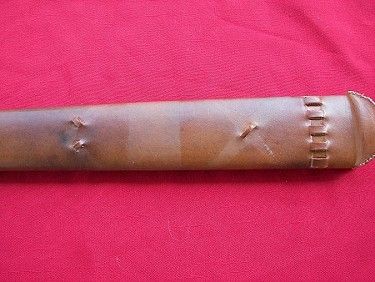
Notice that in the picture above you will need several slits cut into the front of the scabbard. You will have the slits near the top for the weaving of the belt, then the one slit for the "cross" and then two slits further down for the ends of the belts.
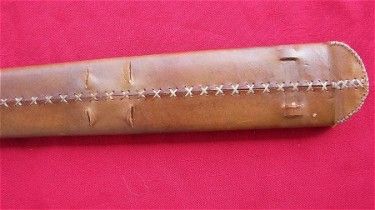
The picture above shows the back of the scabbard, and you will need two sets of slits near the top for the weaving of the belt, and further down 4 slits which will attach the second belt to the scabbard.
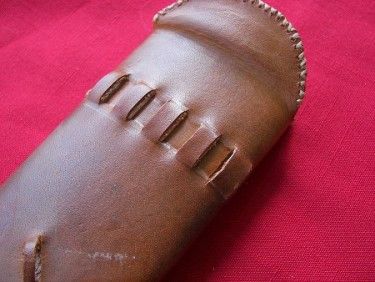
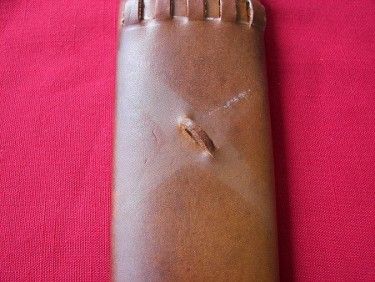
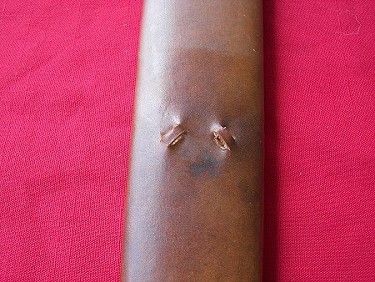
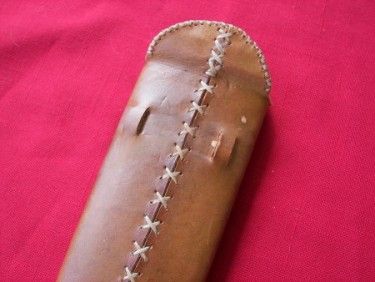
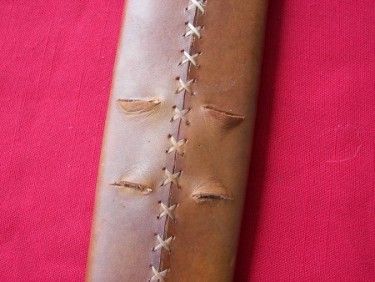
The Belts (Straps)
The pictures below show the two belts. You will not want to cut any of the slits into the belt until you actually start threading them through the slits in the scabbard. The larger belt is pretty simple, you just need to have a loop in one end (snug fit on the scabbard), and the four "attaching" slits. The other belt is much more difficult, so consult the threading pictures below to make sure you understand it. You can use a cloth tape measure and run it around the scabbard, as if you are lacing it. This should give you an idea of the lenght you will need. Always make it longer... you can always trim it later.
The belts shown here are the "tie on" type, you would need to change them a bit for a buckled belt.

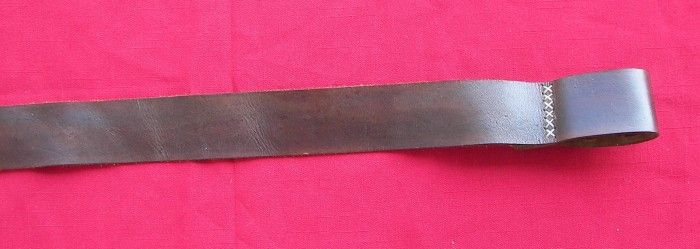

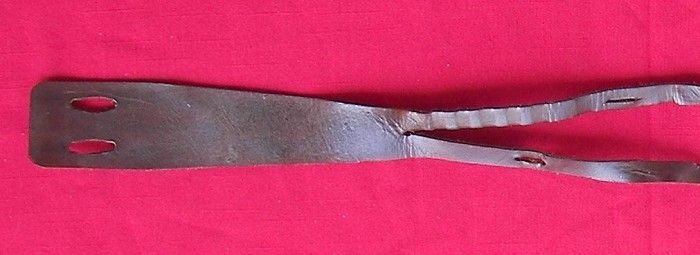
Threading the Belts
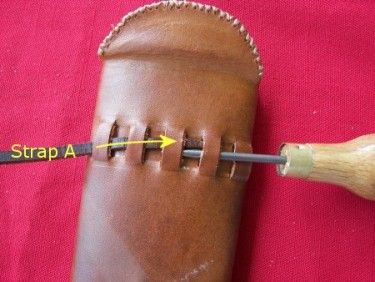
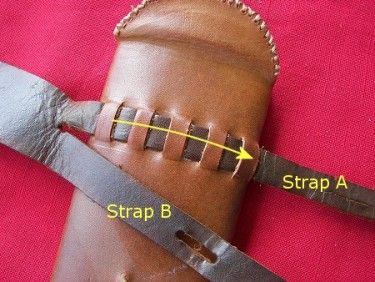


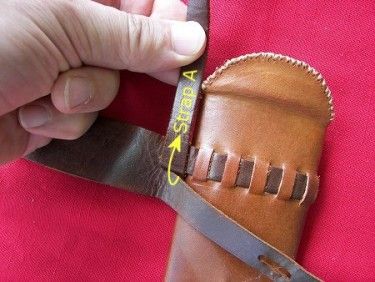

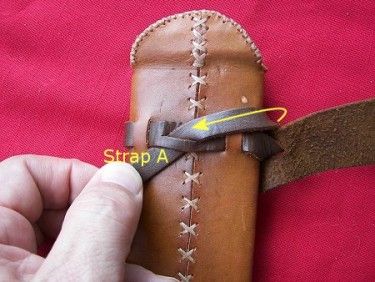
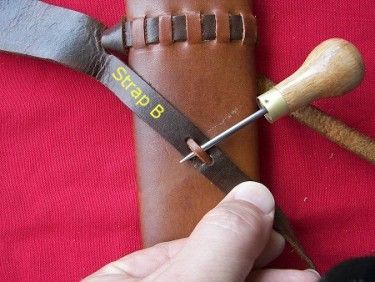
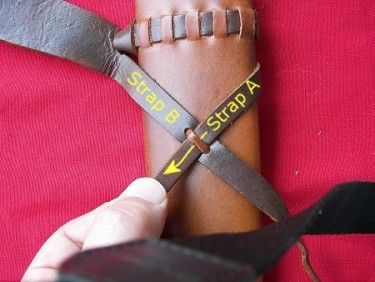
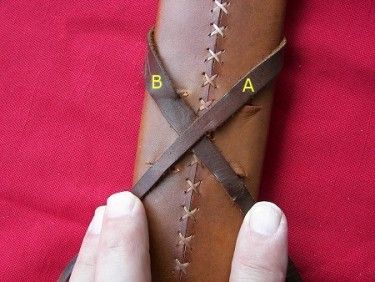
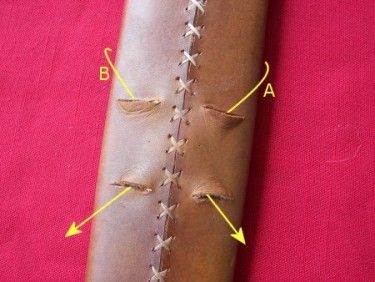
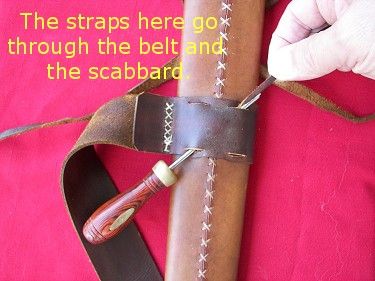
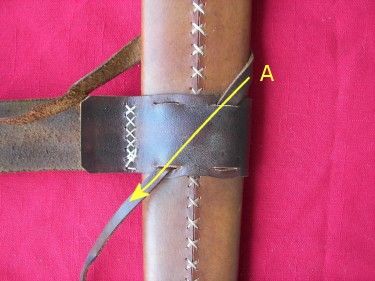

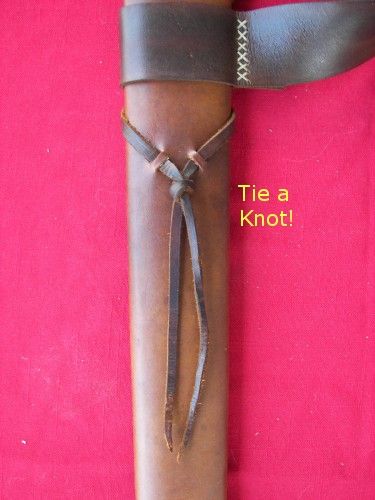
Source: www.yeoldegaffers.com/project_scabbard.asp
I recently tried my hand at some scabbards for a couple of my swords. They are not an easy project, but not as bad as I thought they would be. It is best if you have some leather working experience before you try one, but you don't have to be a leather expert. This project shows the construction of earlier types of scabbards but the idea is pretty much the same for any time line... wood core, covered with leather, some type of belt system....
Please keep in mind that I am not in any ways or means an "expert" in the art of making scabbards. There may be other ways to do this, it is just the way I do it, and I am open to to any comments or suggestions.
Carving Method
This method is how the more expensive scabbards are made, and is a more historic method of producing the wood core.

The first thing you will want to do is to create the wood core. The wood of choice appears to be poplar and that is what I used for my second core. The first core I used was oak, and I have heard that oak might not be the best choice (the oils in oak might not be good for steel?). So I will suggest poplar!
You will want to get two pieces of poplar that are 1/4" thick and a bit longer and wider then your sword blade. You will want to lay your sword, centered, on the each board and draw a pencil line all away around the blade. (see picture above)

Next you will want to chisel, sand, grind, half of the width of the blade from both pieces of the core wood. To be honest this is a bit of a pain, but be careful here, go slow, it is hard to add wood back. When you think you are getting close, clamp both pieces of the core together temporarily, and test fit the blade. Again, just a lot of hit and miss here... but did I mention... go slow!. Keep in mind the shape of the fuller, the distal taper, etc. as you are carving this. The blade should fit snugly, somewhere between falling out, and not having to hammer it in. If you do get it too lose not all is lost. You can add some very thin leather near the mouth to hold the sword in. But not TOO loose... if it is like throwing a hotdog down a hallway then it is way too loose... start over. (the wood is very inexpensive). (see picture above)
Note: I would like to add that it was mentioned that using sandpaper on the inside of the core might result in a bit of the "sand" to be embedded into the core. This could cause a scratching on the blade and to remove the grain of sand you would probably need to destroy the scabbard to get to it. So either do not use sandpaper on the interior of the core, or if you do make sure the core is cleaned good so that no grains will remain.

When are satisfied with the fit then you are ready to glue the two halves together. If you wish you can cut the outside shape before you glue them together, or you can cut them as one piece after you glue them together. Whichever way you choose, be sure that you leave enough room around the core so you don't cut into the grove you have chisled out. You may wish to center the blade on the outside of the core and draw around it as a guide.
If you are using a chape don't forget that you will need to take this into account when shaping the core. I sanded mine until the chape was just a little loose, so it would fit over the leather. Chapes are not easy to find. I actually used the one that came with my swords fiberglass scabbard.
A Historic Method
The "Slat" method project shown below - a simple way to create a core.
Thin slats of wood that are formed over the blade (either formed by steaming/soaking or by cutting), or layers of veneer glued in layers on each side can be seen on surviving examples.

The above picture shows a pile of poplar slats. When Jean recieved these they were veneer cuts, (not cut like regular lumber that most of us would purchase), and still damp (I would assume green), which means they have a bit of natural curve, and ready to be wrapped around the blade.
If you purchase a normal piece of poplar wood slate you will need to steam them(best), or soak them so that they can be bent in a curve. They will also need to be thinned down, with either a planner or sander before steamin/soaking. These slats appear to be around 3/16" thick.

Next you will want to oil the blade well, and then glue and clamp the two halves together. Notice that shape of the scabbard has already been cut out.

Here is a shot looking into the mouth of the scabbard.

The above photo shows the finished core. Looks very nice and clean.

Easy Method
Ok, so this is not really easy, but trust me, it is easier then the above the carving method. This method basiclly makes a 1/4" slot for the blade to slide into. If you happen to have a blade that is thicker than 1/4" then the two side pieces will need to be thicker. If the blade is a bit thinner then a 1/4" (more common), then you can add a bit of leather in the opening to make a very nice, snug fit. This is the method that I used on both of my scabbards below.
For this method you will need two pieces of the 1/4" thick boards a bit longer and wider then your blade. You will also need two side pieces. 1/4" x 1/2", and a bit longer than the the blade should do it.

The first thing you will need to do is lay down your blade on the wood and trace around it with a pencil. You will need to do this on two pieces of wood.

The drawing above shows the pencil tracing of the blade (dark line), and the dotted line shows where you will need to cut it. I usally allow about 3/8". This gives enough room for shaping and sanding. Again, this will need to be done on two pieces of wood.

This picture shows the two pieces of wood glued on. You might notice that I have also shown a small piece of wood glued on near the tip of the scabbard.

Now we will glue on the "top" piece of the scabbard. Try and align it up so it matches the "bottom" piece.

The above drawing shows the scabbard with all of the pieces glued together. Let this dry for a couple of hours.

The last step will be to cut or sand the two pieces that separate the top and bottom parts flush with top and bottom piece.

The last step will be to take the "square" wood scabbard we have made and make it into a nice oval shape. Go slow here, you don't want to remove too much wood!

The above is an actual photo of one of the scabbards I show below. My blade was just a bit loose so I glued a small piece of leather inside the opening, and now the blades fits snug.
After the glue dries you are now ready to shape the core to it's final shape. I use a belt sander for the rough shape, and then finish up with a hand sander. Again, go slow here. You do want to end up with a thin core, but you don't want to sand into the grove. My first core was thicker then my second one, as I had a little more idea what I was doing.
The last step on the core is to finish the outside with a vanish. This protects the core in the long run, and keeps the core from sucking all the moisture from the leather as you are working with it.

My completed core.

The chape end of the core. Notice the chape is a bit loose here... so it will fit over the leather.
Another shot of the core with the blade inserted.

Working with the Leather
I will show several shots of my project in progress.

This picture shows the top pair of risers. I used some small nylon twine that I super glued on.

Here you see both sets of risers and the piece of leather that I used. You will want to use 2 to 3 oz vegetable tanned leather. You can also see all of the holes that you get to punch into the leather. Try to keep the holes evenly spaced from the edge and each other.
Remember to leave some extra leather at the top of the scabbard for the hilt cover.
Figuring out what size to cut the leather is a bit of trial and error. Again, go slow, and trim the width a little at a time. There is no trick here that I am aware of and I have even heard the experts struggle with this a bit. You will be wetting the leather (I soak mine for about 30 minutes) and this will let it stretch a bit. Keep in mind though that when the leather dries it will tighten up.
This would be much easier to size if the scabbard was the same size all the way through it's length, but most will angle smaller towards the chape. If this is your first time trying this you may wish to practice with some paper first.

You don't want too much gap when fitting the leather around the core.

Don't size the leather so that it has wrinkles. You want the finished leather to look taut.

Just a small gap will ensure a nice taut leather cover over the core. When you wet the leather it will be easy to pull this small gap close, and then when it dries it will stretch nicely around the core.
Handle the wet leather carefully. Wet leather is almost clay-like, and it will easily show your fingernails, and dents if you bang it on something while working on it. Of course this may be the look you are after!
Watch the needles while sewing... I will be damned if I can't keep from sticking myself a couple of times every time I sew leather... ouch! I pretty much use artificial sinew thread, but you can also use heavy duty waxed leather thread. DO NOT use regular sewing thread... it is not strong enough.

Here is the leather at the chape end ready to be sewed.


The above drawings show how I use the 2 needle method to sew. This is one of many that can be used, but it is my preference. Keep in mind you don't use blue or red thread, I am just showing the thread in these colors to make it easier to follow. This type of sewing is much like lacing a pair of boots. Trying to figure out how much thread to use is a bit of a guess but around 4 times the length of the scabbard is a good start. It is a little tough when you first start as there is a lot of thread to pull through, but as you move up it gets shorter.
Try to keep the split in the leather running straight up the scabbard as you are sewing. If you do run out of thread while sewing you can tie off a knot (A) and then continue (B) just like you started. Make sure you tie the knot UNDER the scabbard leather so it doesn't show.

This shows the back of scabbard (wet leather) with the sewing completed.


The above pictures shows how I finished the throat of the scabbard. This gives it nice finished look. I sewed all around the throat in one direction, then reversed and sewed back the other way. I only use one needle for this operation.

The above picture shows artificial sinew wrapped around the risers to give them detail. After the leather dries you will remove them.
Keep in mind that the risers were used on this scabbard because of the paticular type of suspension I was using. You may wish to change the spacing of them or not even apply any.
The three pictures below show different examples of hanging scabbards on a belt.



Finishing The Scabbards
I use standard Tandy leather dye to most of my leather. The finished scabbard on the left (below), was finished by staining, and then using a wet sponge I rubbed it down giving it a bit of an antique look. The scabbard on the right was finished by spraying the stain on with a cheapie spray outfit. Spraying will let the stain be more even, and lighter in color. Both belts on the below scabbards were stained by brushing on the stain using a wool dauber. ALWAYS test colors on some scrap leather. What they show and what you get can be two very different things. Even the same color on two different types of leather can show major color differences.
I finish them off by applying 3 coats of paste wax.
Two of My Completed Laced Belt Scabbards
Both of these are a bit simple, as I didn't add any carving or stamping on these scabbards. I do plan on making my next one a bit fancier. I will post some pictures of it when I have completed it.
I am actually suprised how comfortable these are to wear.
Hopefully the pictures below, will show some of the details.





Lacing the Scabbard

I always build the entire scabbard first before I do any staining. All the instructions below assume the scabbard is still a bit wet so the leather will stretch nicely around all of the straps. The first thing you want to do is to create the slits on the top of the scabbard. You need to determine the spacing and size of the slits to be cut. This is a matter of personal taste, on this project I am using five. I try to evenly space them so that the slits and the spaces between them are equal, again, a matter of personal taste.
Carefully measure them and mark the leather lightly with a pencil or an awl. Next using an X-Acto knife cut the slits on the lines as shown in the graphic above. You will want to cut the slits just a bit longer then the width of the strap that will be going through them. In other words, if you are using a 1/2" strap, then cut the slots about 5/8" long. Be careful here... don't let the knife slip. Also don't cut much deeper then the leather thickness, a little cut into the wood is ok.
NOTE: Act like the scabbard in all the below pictures has not been stained yet. It was easier to take pictures after I completed everything, and then take it back apart.


Next while the leather is still a bit wet you will feed the leather strap through the slits as shown above. This might be a bit tough to feed through, and you can use a small screwdriver to pry up the slits a bit as you are feeding the leather through. Wet leather is strechty and with the screwdriver you can slowly form the leather so that it creates a "tunnel" for the straps. Go slow and don't force it. You may wish to practice this on some test leather to get the feel for it. You want the slits to be tight enough around the strap so that they fold neatly around the strap, and appear to be formed around it.
Instead of trying to thread the entire belt (straps) through the scabbard while it is wet you could use scrap pieces of leather that is the same thickness of the straps. You will want to leave these pieces in the scabbard until it has totally dried. The slits should more or less retain their shape, ready for the real straps at a latter time. See pictures above. Notice that I use two pieces of leather in the center slit since it needs to have a pretty good stretch to it.
The Slits
In the following pictures below I show all the slits that need to be cut into the leather.

Notice that in the picture above you will need several slits cut into the front of the scabbard. You will have the slits near the top for the weaving of the belt, then the one slit for the "cross" and then two slits further down for the ends of the belts.

The picture above shows the back of the scabbard, and you will need two sets of slits near the top for the weaving of the belt, and further down 4 slits which will attach the second belt to the scabbard.





The Belts (Straps)
The pictures below show the two belts. You will not want to cut any of the slits into the belt until you actually start threading them through the slits in the scabbard. The larger belt is pretty simple, you just need to have a loop in one end (snug fit on the scabbard), and the four "attaching" slits. The other belt is much more difficult, so consult the threading pictures below to make sure you understand it. You can use a cloth tape measure and run it around the scabbard, as if you are lacing it. This should give you an idea of the lenght you will need. Always make it longer... you can always trim it later.
The belts shown here are the "tie on" type, you would need to change them a bit for a buckled belt.




Threading the Belts















Source: www.yeoldegaffers.com/project_scabbard.asp

.png?width=1920&height=1080&fit=bounds)